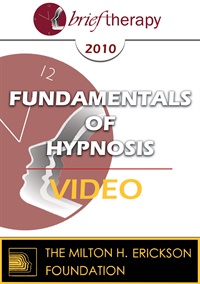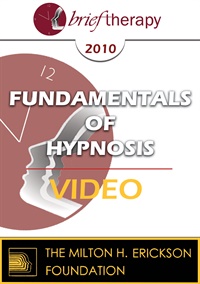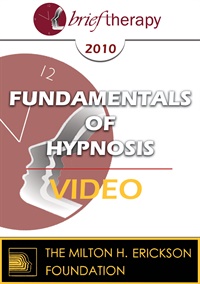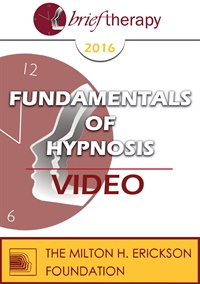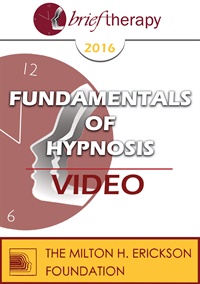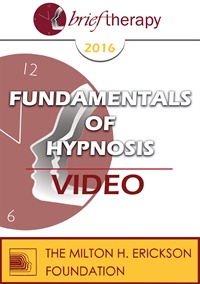- Average Rating:
- Not yet rated
- Topic Areas:
- Fundamentals of Hypnosis | Hypnosis | Phenomenology | Hypnotic Induction | Trance | Tailoring
- Categories:
- Brief Therapy Conference | Brief Therapy Conference 2008
- Faculty:
- Jeffrey Zeig, PhD
- Course Levels:
- Master Degree or Higher in Health-Related Field
- Duration:
- 2:23:04
- Format:
- Audio and Video
- Original Program Date:
- Dec 11, 2008
- Short Description:
- Hypnosis is not a thing, but a way that things happen. To make hypnosis happen a clinician needs to understand the underlying architecture of trance. Eliciting systemic components elicits trance. The grammar, context and relational elements of eliciting these components will be explained. We will develop an induction model based on three steps. This workshop will consist of lecture, demonstration and small group practice.
- Price:
- $29.00 - Base Price
- Average Rating:
- Not yet rated
- Topic Areas:
- Fundamentals of Hypnosis | Hypnosis | Language of Hypnosis | Indirection
- Categories:
- Brief Therapy Conference | Brief Therapy Conference 2008
- Faculty:
- Stephen Lankton, MSW
- Course Levels:
- Master Degree or Higher in Health-Related Field
- Duration:
- 2:09:12
- Format:
- Audio and Video
- Original Program Date:
- Dec 12, 2008
- Short Description:
- The rationale for the use of indirection will be presented. In this session you will learn and practice the construction of fundamental forms of indirection language. Participants will practice five forms of indirect suggestions and three forms of binds. A demonstration using these forms will illustrate the implementation of this set of language techniques for the induction and treatment process. The use of indirect suggestions in further treatment will be outlined.
- Price:
- $29.00 - Base Price
- Average Rating:
- Not yet rated
- Topic Areas:
- Fundamentals of Hypnosis | Hypnosis | Hypnotic Induction | Resources | Trance
- Categories:
- Brief Therapy Conference | Brief Therapy Conference 2008
- Faculty:
- Stephen Gilligan, PhD
- Course Levels:
- Master Degree or Higher in Health-Related Field
- Duration:
- 2:26:46
- Format:
- Audio and Video
- Original Program Date:
- Dec 12, 2008
- Short Description:
- This session explores various methods for eliciting hypnotic trance in a therapy situation. The relevance of utilizing key aspects of a client's resources and symptoms, as well as different ways to gage and incorporate ongoing feedback will be emphasized.
- Price:
- $29.00 - Base Price
- Average Rating:
- Not yet rated
- Topic Areas:
- Fundamentals of Hypnosis | Hypnosis | Goals of the Therapist | Psychotherapy
- Categories:
- Brief Therapy Conference | Brief Therapy Conference 2008
- Faculty:
- Michael Yapko, PhD
- Course Levels:
- Master Degree or Higher in Health-Related Field
- Duration:
- 2:47:38
- Format:
- Audio and Video
- Original Program Date:
- Dec 14, 2008
- Short Description:
- This workshop shows how hypnosis can be used as a goal-oriented, brief therapy, illustrated through live demonstrations and group participation. Participants experience how guided attention, metaphor, and suggestion help uncover overlooked resources and reframe familiar struggles. The session highlights real-world examples of how hypnosis amplifies client strengths, manages pain, and supports emotional regulation, offering practical strategies for fostering resilience and change.
- Price:
- $29.00 - Base Price
- Average Rating:
- Not yet rated
- Topic Areas:
- Fundamentals of Hypnosis | Hypnosis | Hypnotic Induction
- Categories:
- Brief Therapy Conference | Brief Therapy Conference 2008
- Faculty:
- Ernest Rossi, PhD
- Course Levels:
- Master Degree or Higher in Health-Related Field
- Duration:
- 2:17:49
- Format:
- Audio and Video
- Original Program Date:
- Dec 14, 2008
- Short Description:
- Three brief, novel, creative and easy to learn approaches to the induction of therapeutic hypnosis that are appropriate for practically any client issue with any theoretical orientation will be shared with participants. All of these approaches have evolved from Erickson's original "hand levitation technique" and are consistent with the principles of art, beauty, and truth presented in the new 2008 series of "The Collected Works of Milton H. Erickson," Vol.1, "The Nature of Therapeutic Hypnosis."
- Price:
- $29.00 - Base Price
- Average Rating:
- Not yet rated
- Topic Areas:
- Hypnosis | Fundamentals of Hypnosis | Ericksonian Hypnosis and Therapy Techniques
- Categories:
- Brief Therapy Conference | Brief Therapy Conference 2010
- Faculty:
- Michael Yapko, PhD
- Course Levels:
- Master Degree or Higher in Health-Related Field
- Duration:
- 2:18:50
- Format:
- Audio and Video
- Original Program Date:
- Dec 09, 2010
- Short Description:
- This session provides an orientation to the language, structures, and phenomena of hypnosis, highlighting its role as a vehicle for therapeutic change rather than a standalone therapy. Emphasizing suggestion, dissociation, and automatic responses, the workshop explores how hypnosis enhances psychotherapy by fostering experiential learning and accessing hidden capacities. Participants gain a clear framework for integrating hypnosis into clinical practice, from symptom management to resource activation and reframing, while appreciating its empirical foundations in pain, anxiety, and depression.
- Price:
- $29.00 - Base Price
- Average Rating:
- Not yet rated
- Topic Areas:
- Hypnosis | Fundamentals of Hypnosis | Phenomenology | Trance
- Categories:
- Brief Therapy Conference | Brief Therapy Conference 2010
- Faculty:
- Jeffrey Zeig, PhD
- Course Levels:
- Master Degree or Higher in Health-Related Field
- Duration:
- 2:15:55
- Format:
- Audio and Video
- Original Program Date:
- Dec 10, 2010
- Short Description:
- Deconstructing trance into phenomenological components allows the hypnotherapist to target intensions strategically. Hypnosis will be divided into social, psychological, and interpersonal elements. Lecture, demonstration, and small group practice.
- Price:
- $29.00 - Base Price
- Average Rating:
- Not yet rated
- Topic Areas:
- Hypnosis | Fundamentals of Hypnosis | Ericksonian Hypnosis and Therapy Techniques | Treatment Planning
- Categories:
- Brief Therapy Conference | Brief Therapy Conference 2010
- Faculty:
- Bill O'Hanlon, MS
- Course Levels:
- Master Degree or Higher in Health-Related Field
- Duration:
- 2:04:56
- Format:
- Audio and Video
- Original Program Date:
- Dec 10, 2010
- Short Description:
- In this session, you will learn a clear model that will allow you to rapidly conceptualize problems, sort them for appropriateness for hypnotic intervention, and create multiple interventions. You will also learn five delivery methods for interventions.
- Price:
- $29.00 - Base Price
- Average Rating:
- Not yet rated
- Topic Areas:
- Hypnosis | Hypnotherapy | Fundamentals of Hypnosis | Ericksonian Hypnosis and Therapy Techniques | Utilization
- Categories:
- Brief Therapy Conference | Brief Therapy Conference 2010
- Faculty:
- Stephen Gilligan, PhD
- Course Levels:
- Master Degree or Higher in Health-Related Field
- Duration:
- 2:15:55
- Format:
- Audio and Video
- Original Program Date:
- Dec 12, 2010
- Short Description:
- This workshop provides an overview of the Ericksonian theory of utilization and then explores through demonstration, clinical examples, and a brief group exercise how to incorporate a client's processes—positive and negative associations, positive goals, desired futures, ongoing behaviors--in both the induction and utilization parts of Ericksonian hypnotherapy.
- Price:
- $29.00 - Base Price
- Average Rating:
- Not yet rated
- Topic Areas:
- Hypnosis | Fundamentals of Hypnosis | Neuroscience
- Categories:
- Brief Therapy Conference | Brief Therapy Conference 2010
- Faculty:
- Ernest Rossi, PhD
- Course Levels:
- Master Degree or Higher in Health-Related Field
- Duration:
- 2:43:01
- Format:
- Audio and Video
- Original Program Date:
- Dec 12, 2010
- Short Description:
- Revolutionary research in neuroscience documents how experiences of (1) Novelty, (2) Environment Enrichment, and (3) Mental & Physical Exercise can optimize gene expression, brain plasticity (brain growth), and mind-body healing. We will learn how to use our highest and most inspired states of consciousness to facilitate optimal gene expression and brain plasticity while healing stress and trauma.
- Price:
- $29.00 - Base Price
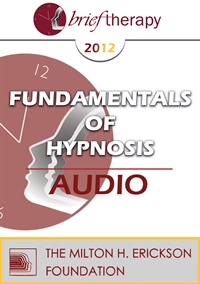
- Average Rating:
- Not yet rated
- Topic Areas:
- Hypnosis | Fundamentals of Hypnosis | Hypnotic Induction
- Categories:
- Brief Therapy Conference | Brief Therapy Conference 2012
- Faculty:
- Brent Geary, PhD
- Duration:
- 2:30:16
- Format:
- Audio Only
- Original Program Date:
- Dec 06, 2012
- Short Description:
- This segment will cover essential topics and terminology in hypnosis. The process of a hypnotic session will be explained. Participants will practice observing and elicitation of focused awareness in hypnotic subjects.
- Price:
- $15.00 - Base Price
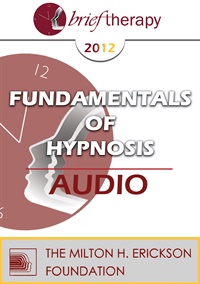
- Average Rating:
- Not yet rated
- Topic Areas:
- Hypnosis | Fundamentals of Hypnosis | Hypnotic Induction | Workshops
- Categories:
- Brief Therapy Conference | Brief Therapy Conference 2012
- Faculty:
- Brent Geary, PhD
- Duration:
- 2:04:01
- Format:
- Audio Only
- Original Program Date:
- Dec 06, 2012
- Short Description:
- Various frameworks for hypnotic induction will be explained, demonstrated, and practiced during this portion of the training.
- Price:
- $15.00 - Base Price
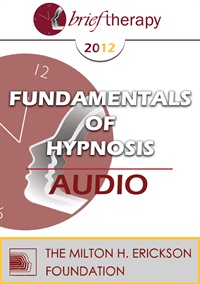
- Average Rating:
- Not yet rated
- Topic Areas:
- Hypnosis | Fundamentals of Hypnosis | Workshops | Hypnotic Phenomena
- Categories:
- Brief Therapy Conference | Brief Therapy Conference 2012
- Faculty:
- Brent Geary, PhD
- Duration:
- 2:06:54
- Format:
- Audio Only
- Original Program Date:
- Dec 08, 2012
- Short Description:
- The utilization of hypnosis always involves the hypnotic phenomena. This session will explore the various phenomena and their role in clinical contexts. Participants will practice elicitation of hypnotic phenomena.
- Price:
- $15.00 - Base Price
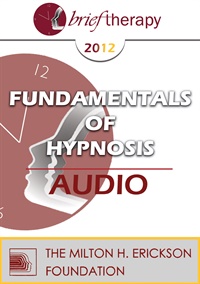
- Average Rating:
- Not yet rated
- Topic Areas:
- Hypnosis | Fundamentals of Hypnosis | Workshops | Indirection
- Categories:
- Brief Therapy Conference | Brief Therapy Conference 2012
- Faculty:
- Brent Geary, PhD
- Duration:
- 1:54:19
- Format:
- Audio Only
- Original Program Date:
- Dec 08, 2012
- Short Description:
- One of Erickson’s landmark contributions to hypnosis was his introduction of indirection as a therapeutic approach. This final section of the training explores the ways in which anecdotes, metaphors, and other indirect methods can be utilized.
- Price:
- $15.00 - Base Price
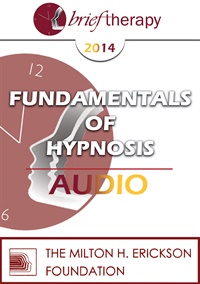
- Average Rating:
- Not yet rated
- Topic Areas:
- Hypnosis | Hypnotic Induction | Fundamentals of Hypnosis | Ericksonian Hypnosis and Therapy Techniques
- Categories:
- Brief Therapy Conference | Brief Therapy Conference 2014
- Faculty:
- Jeffrey Zeig, PhD
- Duration:
- 5:38:29
- Format:
- Audio Only
- Original Program Date:
- Dec 12, 2014
- Short Description:
- What is hypnosis? What is the Ericksonian difference? How do you help clients elicit a constructive trance experience? What is the most effective way to strengthen messages? In experiential workshop, participants will learn how to elicit a trance state and how to enhance responsiveness. Powerful hypnotic language forms can be tailored so that a trance is developed in an appropriate and efficient way for each client. Demonstration inductions, and work in small groups to induce and experience hypnotic states. Targeted to the beginner. No previous experience necessary. This is a one-day workshop and attendees are expected to attend all sessions.
- Price:
- $15.00 - Base Price
- Average Rating:
- Not yet rated
- Topic Areas:
- Hypnosis | Fundamentals of Hypnosis | Hypnotic Induction | Hypnotic Phenomena | Indirection | Metaphors
- Categories:
- Brief Therapy Conference | Brief Therapy Conference 2016
- Faculty:
- Brent Geary, PhD
- Course Levels:
- Master Degree or Higher in Health-Related Field
- Duration:
- 1:22:28
- Format:
- Audio and Video
- Original Program Date:
- Dec 07, 2016
- Short Description:
- Coverage begins with essential topics and terminology in hypnosis. The process of a hypnotic session will be explained. (Participants will practice observing and elicitation of focused awareness in hypnotic subjects.) Various frameworks for hypnotic induction will be explained, demonstrated. The utilization of hypnosis always involves the hypnotic phenomena.
- Price:
-
Sale is $29.00
price reduced from Base Price - $59.00
- Average Rating:
- Not yet rated
- Topic Areas:
- Hypnosis | Fundamentals of Hypnosis | Hypnotic Induction | Hypnotic Phenomena | Indirection | Metaphors
- Categories:
- Brief Therapy Conference | Brief Therapy Conference 2016
- Faculty:
- Brent Geary, PhD
- Course Levels:
- Master Degree or Higher in Health-Related Field
- Duration:
- 1:46:32
- Format:
- Audio and Video
- Original Program Date:
- Dec 07, 2016
- Short Description:
- Coverage begins with essential topics and terminology in hypnosis. The process of a hypnotic session will be explained. (Participants will practice observing and elicitation of focused awareness in hypnotic subjects.) Various frameworks for hypnotic induction will be explained, demonstrated. The utilization of hypnosis always involves the hypnotic phenomena.
- Price:
-
Sale is $29.00
price reduced from Base Price - $59.00
- Average Rating:
- Not yet rated
- Topic Areas:
- Hypnosis | Fundamentals of Hypnosis | Hypnotic Induction | Hypnotic Phenomena | Indirection | Metaphors
- Categories:
- Brief Therapy Conference | Brief Therapy Conference 2016
- Faculty:
- Brent Geary, PhD
- Course Levels:
- Master Degree or Higher in Health-Related Field
- Duration:
- 2:32:02
- Format:
- Audio and Video
- Original Program Date:
- Dec 07, 2016
- Short Description:
- Coverage begins with essential topics and terminology in hypnosis. The process of a hypnotic session will be explained. (Participants will practice observing and elicitation of focused awareness in hypnotic subjects.) Various frameworks for hypnotic induction will be explained, demonstrated. The utilization of hypnosis always involves the hypnotic phenomena. A part of the workshop will explore the various phenomena and their role in clinical contexts.
- Price:
-
Sale is $29.00
price reduced from Base Price - $59.00

- Average Rating:
- Not yet rated
- Topic Areas:
- Special Topics | Hypnosis | Ericksonian Hypnosis and Therapy Techniques | Fundamentals of Hypnosis | Psychotherapy | Truisms | Age Regression | Hypnotic Phenomena | Post-Hypnotic Suggestion | Suggestion | Metaphors
- Categories:
- Brief Therapy Conference | Brief Therapy Conference 2018
- Faculty:
- Brent Geary, PhD
- Duration:
- 5:14:31
- Format:
- Audio Only
- Original Program Date:
- Dec 05, 2018
- Short Description:
- This workshop will provide participants with an introduction to the key concepts and techniques of practice in Ericksonian hypnosis. A brief biography of Erickson’s professional life will provide perspective on the extensive contributions he made to the fields of hypnosis and psychotherapy. Terminology of hypnosis will be explained and various approaches to induction will be described and demonstrated. The process of a typical hypnotic session will be outlined. Considerable attention will be afforded the hypnotic phenomena, the essential mechanisms in hypnotic therapy. Erickson’s landmark concepts of utilization and indirection will be explored with particular focus on the use of therapeutic anecdotes and metaphors.
- Price:
- $15.00 - Base Price
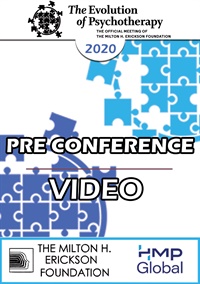
- Average Rating:
- Not yet rated
- Topic Areas:
- Pre-Conference Sessions | Fundamentals of Hypnosis | Ericksonian Hypnosis and Therapy Techniques
- Categories:
- Evolution of Psychotherapy | Evolution of Psychotherapy 2020
- Faculty:
- Michael Yapko, PhD
- Course Levels:
- Master Degree or Higher in Health-Related Field
- Duration:
- 6 hours
- Format:
- Audio and Video
- Original Program Date:
- Dec 08, 2020
- Short Description:
- This event offers a clear, practical foundation in clinical hypnosis. Participants learn how attention, dissociation, and suggestion can shape therapeutic change, and how to integrate hypnosis into psychotherapy for depression, trauma, and pain. Emphasis is placed on individualized, goal-oriented methods that strengthen focus, flexibility, and self-regulation.
- Price:
-
Sale is $49.00
price reduced from Base Price - $99.00

- Average Rating:
- Not yet rated
- Topic Areas:
- Hypnotherapy | Fundamentals of Hypnosis | Hypnosis
- Categories:
- Fundamentals of Ericksonian Hypnotherapy
- Faculty:
- Stephen Lankton, MSW | Ernest Rossi, PhD | Betty Alice Erickson, MS, LPC, LMFT | Michael Yapko, PhD | Stephen Gilligan, PhD
- Course Levels:
- Master Degree or Higher in Health-Related Field
- Duration:
- 10 hours
- Format:
- Audio and Video
- Original Program Date:
- Dec 01, 2004
- Short Description:
- Presented at The Ninth International Congress on Ericksonian Approaches to Hypnosis and Psychotherapy
- Price:
- $199.00 - Base Price

- Average Rating:
- Not yet rated
- Topic Areas:
- Hypnotherapy | Fundamentals of Hypnosis | Hypnosis
- Categories:
- Fundamentals of Ericksonian Hypnotherapy
- Faculty:
- Brent Geary, PhD | Stephen Gilligan, PhD | Stephen Lankton, MSW | Ernest Rossi, PhD | Dan Short, PhD | Michael Yapko, PhD | Lilian Borges, MA, LPC | Jeffrey Zeig, PhD
- Course Levels:
- Master Degree or Higher in Health-Related Field
- Duration:
- 14 hours
- Format:
- Audio and Video
- Original Program Date:
- Dec 05, 2007
- Short Description:
- The Observation-Suggestion Combination with Brent B. Geary, Ph.D The Use of the Therapist’s Self in Hypnotherapy with Stephen Gilligan, Ph.D The Development and Use of Self-Image Thinking in Therapy with Stephen Lankton, M.S.W., DAHB Brief Bioinformatic Approaches to Therapeutic Hypnosis Ernest Rossi, Ph.D The Fundamentals of Permissive Suggestion with Dan Short, Ph.D Accessing and Contextualizing Resources Hypnosis Michael Yapko, Ph.D Utilization with Lilian Borges Zeig, MA The Phenomenology of Induction with Jeffrey Zeig, Ph.D.
- Price:
- $199.00 - Base Price

- Average Rating:
- Not yet rated
- Topic Areas:
- Hypnotherapy | Fundamentals of Hypnosis | Hypnosis
- Categories:
- Fundamentals of Ericksonian Hypnotherapy
- Faculty:
- Stephen Gilligan, PhD | Stephen Lankton, MSW | Ernest Rossi, PhD | Michael Yapko, PhD | Jeffrey Zeig, PhD
- Course Levels:
- Master Degree or Higher in Health-Related Field
- Duration:
- 12.5 hours
- Format:
- Audio and Video
- Original Program Date:
- Dec 10, 2008
- Short Description:
- Induction Methods I with Stephen Gilligan, PhD Indirection-Basic and Intermediate Language Skills in Hypnosis with Stephen Lankton, MSW, DAHB Induction Methods II: Three Novel Approaches to the Induction of Therapeutic Hypnosis with Ernest Rossi, PhD Hypnosis as a Goal-Oriented Brief Psychotherapy with Michael Yapko, PhD The Phenomenology of Hypnosis with Jeffrey Zeig, PhD
- Price:
- $199.00 - Base Price
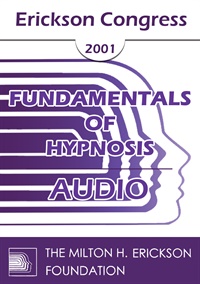
- Average Rating:
- Not yet rated
- Topic Areas:
- Fundamentals of Hypnosis | Neuroscience | Hypnosis
- Categories:
- Erickson Congress 2001 | Erickson Congress
- Faculty:
- Ernest Rossi, PhD
- Duration:
- 1:43:04
- Format:
- Audio Only
- Original Program Date:
- Dec 07, 2001
- Short Description:
- This is a practical, personal growth workshop demonstrating how the new neuroscience principles of novelty, enrichment and physical exercise can be facilitated with creative replay and reframing as the fundamental dynamics of Erickson's work.
- Price:
- $15.00 - Base Price
Tags: Fundamentals of Hypnosis
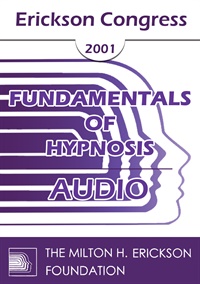
- Average Rating:
- Not yet rated
- Topic Areas:
- Fundamentals of Hypnosis | Hypnosis | Language of Hypnosis
- Categories:
- Erickson Congress 2001 | Erickson Congress
- Faculty:
- Betty Alice Erickson, MS, LPC, LMFT
- Duration:
- 1:48:16
- Format:
- Audio Only
- Original Program Date:
- Dec 07, 2001
- Short Description:
- IC01 Fundamental Hypnosis 02 - Speaking the Client's Language: Rapport for Change - Betty Alice Erickson, MS, LPC, LMFT
- Price:
- $15.00 - Base Price
Tags: Fundamentals of Hypnosis





